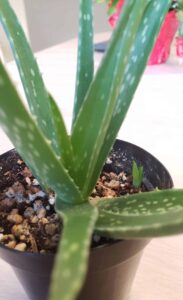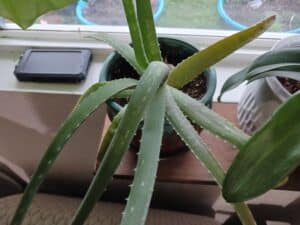Like any succulent, Aloe Vera is prone to overwatering issues if grown in general soil, uprooting it from the desert surface. So, the growing medium must be able to drain well.
Native to Arabian Peninsula, Aloe Vera grows in well-dry and sandy soil and becomes a hardy plant in the succulents. So, you need not offer it compact soil.
Table of Contents Show
What Kind of Potting Soil is Best for Aloe Vera?
Aloe Vera’s first written history goes back to Ancient Egypt, where the famed “plant of immortality” was preferably grown without using soil.
Indeed, Aloe Vera is not suited for regular soil because it tends to be heavy, remain soggy, and compact over time.
This succulent thrives in the light substrate that provides good drainage, helps retain nutrients and oxygen, and provides support.

Therefore, choose these succulent soil types when growing Aloe Vera in a pot or outdoors.
| Soil Type | Specification |
|---|---|
| Sandy Soil | It consists large particles of sand, typically 0.05 to 2.0 mm in diameter. It provides good drainage and allows air to circulate around the roots. |
| Cacti Soil | It consists sand, perlite, and other organic materials like peat moss and limestone. It promote good drainage and is slightly alkaline. |
| Loamy Soil | It is a mix of light particles like sand, silt, and clay. It promotes good drainage, nutrients, and water retention. |
Let us now look at the characteristics of the best Aloe Vera soil.
1. Well-draining
A desert-like plant, Aloe prefers well-draining soil that allows water to move through it quickly and freely.
Remember, well-draining soil never gets waterlogged and prevents excess moisture from accumulating around the roots.
Generally, you have well-draining soil if the water drains from the drainage hole in 5-10 minutes or less.
2. Porous Quality
Porous soil quality contains spaces or pores between the soil particles, allowing for aeration and proper water drainage.
Aloe prefers porous soil mix, so their roots do not stay moist for long.
Additionally, aerated soil encourages air circulation around their fibrous roots.
3. Slightly Acidic
Aloe prefers slightly acidic soil with a pH between 6.0 and 7.0, but not too acidic.
If the soil is too alkaline or acidic, it can affect the Aloe’s ability to take up nutrients and grow properly.
Additionally, highly acidic soil damages the roots, and alkaline soil invites pests and diseases.
4. Nutrient Rich
The succulent mix naturally lacks the essential nutrients required for Aloe Vera, but it does not mean the plant will tolerate it.
You should regularly feed your plant or amend the sterile succulent mix with decayed matter such as compost to encourage a nutrient boost in the soil.
Choose a liquid 10-10-10 houseplant fertilizer or any slow-releasing plant food explicitly designed for succulents.
5. Sterile Condition
Using a sterile soil mix ensures the plant is free of pathogens and other harmful organisms.
Therefore, sterilize your succulent mix with heat or rubbing alcohol before using it to ensure zero soil microbes.
Signs of Using the Wrong Soil Mix for Aloe Vera
Unlike other houseplants, Aloe Vera does not quickly succumb to ailment.
However, using the wrong potting mix and poor soil drainage can progressively weaken your plant.
Look for telltale signs to know whether your Aloe needs a soil change.
- Yellowing leaves: The poor draining soil mix can lead to waterlogged soil, which causes the Aloe Vera leaves to turn yellow and brown in color to wilt.

- Root rot: Root rot is common in Aloe Vera when the soil remains soggy for a long time, usually due to poor drainage and overwatering. It leads to mushy roots and stunted growth.
- Poor or Slowed growth: The plant suffers slow growth when the soil mix lacks the necessary nutrients and remains soggy or compact over time.
- Leaf drooping: The too-dense or compacted soil mix can make it difficult for the plant to absorb necessary water and nutrients, causing the leaves to transpire and droop.
- Fungal growth: Poor soil drainage and using infected garden soil can cause fungal growth on the leaves or stems of the Aloe Vera plant, inviting leaf spots or discoloration.
- Thin, spindly growth: If your Aloe Vera lacks sunlight and soil nutrients, it will exhibit lean, skeletal growth.
- Lack of firmness: If the soil mix is too dry or light, the aloe leaves may lack firmness and feel limp to the touch.
Best Commercial Soil for Aloe Vera
It is unsafe to provide Aloe Vera with all-purpose or general garden soil.
The best thing is that you can easily find a different kind of succulent mix appropriate for Aloe Vera in the market.
| Potting Mix | Advantages |
|---|---|
| Miracle-Gro Cactus, Palm & Citrus Soil | It is a fast-draining formula of sand and perlite to help create the optimal growing substrate. The soil is fortified with iron and compost to prevent leaf yellowing. |
| Miracle-Gro Indoor Potting Mix | The coco coir mix is appropriate for a various types of houseplants. It is less prone to gnats (contains no compost or bark known to shelter fungus gnats). |
| Bonsai Soil All Purpose Mix | Fast draining Bonsai potting soil mix contains pumice, black lava rock, caclined clay, and pine bark fines. It provides the roots with optimal drainage, pH balance, water retention and nutrient uptake and aeration. |
| Succulent & Cactus Soil Mix | It is prepared with non-organic components such as 1/4 Hard Japanese Akadama, 1/4 USA Pumice, 1/4 New Zealand Pine Bark, and 1/4 Haydite. It provides optimal drainage, water retention, nutrient uptake and aeration. |
How to Make Soil for Aloe Vera? (Potting Mix Recipes)
Making homemade succulent mix allows you to control the quality and determine the correct proportion of ingredients for Aloe Vera.
Ensure the indoor and outdoor Aloe Vera mix is equally well-draining. Use a good mix containing perlite, lava rock, and chunks of bark.
Here are three DIY ideas to create a homemade aloe mix quickly.
Basic Recipe
- Mix equal parts of perlite and coarse sand.
- Top it with a handful of worm castings or compost to promote microbial activity.
- Adjust the mix by adding more sand for better drainage as necessary.
Nutrient-Rich Recipe
- Combine equal parts of perlite and coconut coir for water retention.
- Add a handful of worm castings, compost, and vermiculite to boost nutrients.
- Adjust the mix by topping up perlite for better drainage or coconut coir for water retention.
Alternative Recipe
- Make equal parts of peat moss, perlite, and vermiculite to create a generic houseplant mix.
- Top it with a handful of bone meal or rock phosphate for slow-release nutrients.
- Adjust the amount of perlite to improve drainage or remove peat moss to prevent excess water retention.
Regardless of the recipe, use a pot with multiple drainage holes to prevent waterlogging.
From Editorial Team
Some Extra Advice on Aloe Vera Soil
Regardless of size, the soil requirement is similar to all age groups of Aloe plants.
However, if you grow Aloe Vera in nonporous soil, you need to add more perlite and pumice to the potting mix or soil for better drainage.
